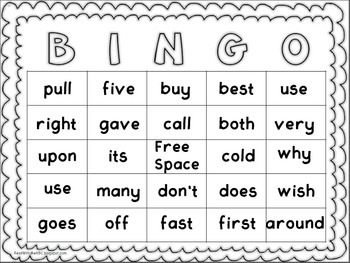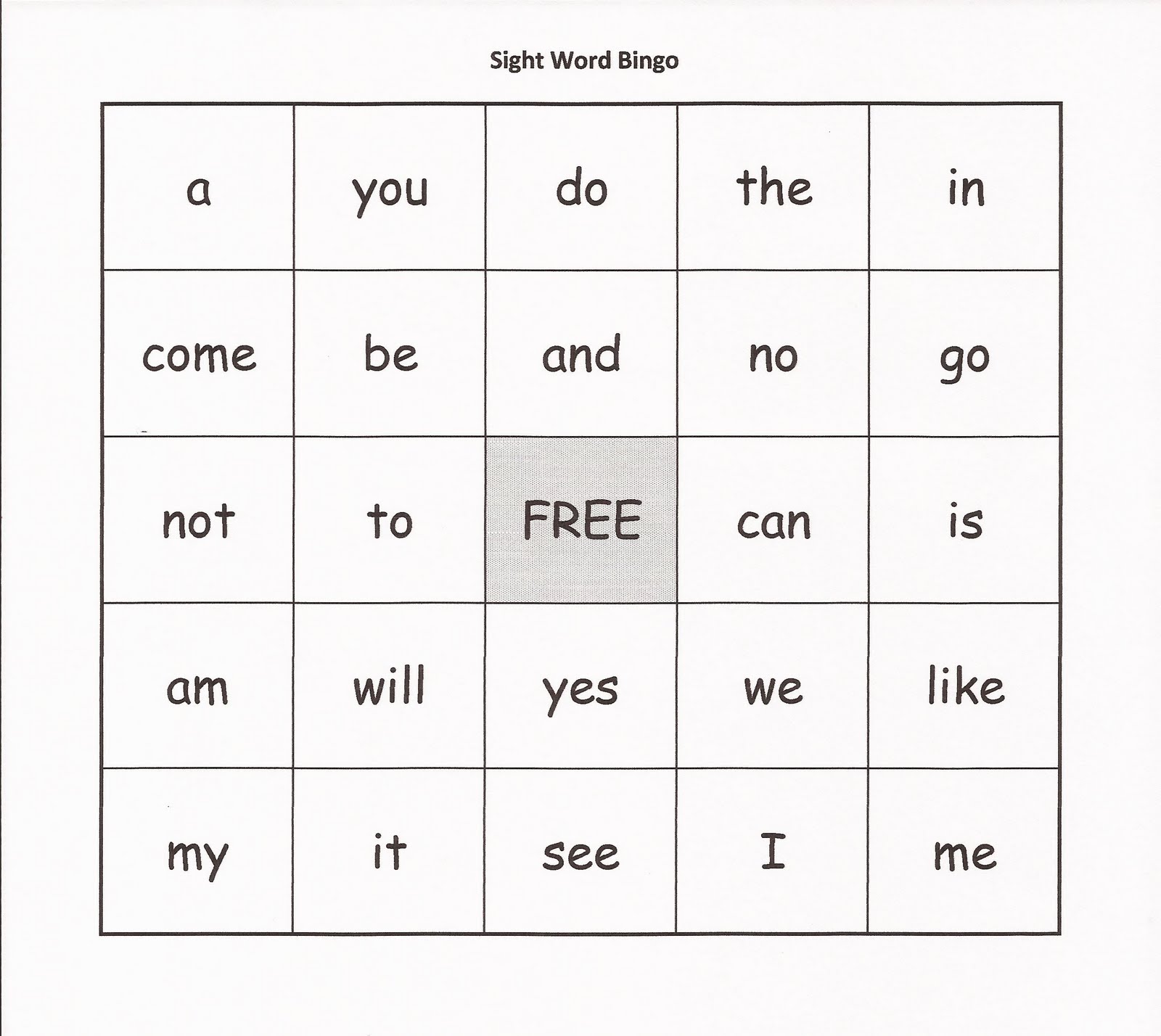Sight Words Bingo
Do your children grumble and complain when you want them to practice their sight words?
Mine do!
With school reading starting this week I’m sure you will be practicing with your little ones so that they can progress with their home readers.
It got me thinking…. Why not make it fun?
Sight Words Bingo is our most popular sight words game. It takes the traditional Bingo game and replaces the numbers with words, motivating the child to read the sight words so they can play (and win!) the game. Children love playing Sight Words Bingo, and it is a great way to provide repetition opportunities in a large group setting. High Frequency Sight Word Bingo Printables I had the idea to make a sight word bingo game using my daughters’ high frequency sight words. She came home a few days ago saying that she had so much fun playing bingo at school, but that she never wins. Argh sight words! I used to really dread them when I was teaching. This is a crazy number of fun activities though:) Jack is not really interested in learning to read too much yet, which is fine, he can do c-v-c put that's it at the moment. I wasn't looking forward to introducing sight words but these look fun:) I even love the scrabble:). Sight Words bingo card with am, my, three, there, how, many, they, some, water and these.
If it was a game the kids would be more inclined to want to practice. Maybe they would not even realise they are practicing their sight words, and just think it’s a game.

The Dolch Sight Words list is the most commonly used set of sight words. Edward William Dolch developed the list in the 1930s-40s by studying the most frequently occurring words in children’s books of that era. The list contains 220 “service words” plus 95 high-frequency nouns.
What is Sight Word Bingo?
Sight word bingo is like regular bingo but without numbers, it uses words. The words you select are aligned to your child’s level at school and reading.
Sight Words Bingo Sheets
How to play Sight Word Bingo
- Each child gets a different bingo card. (When you print out your cards on Sight Word Bingo Creatoryou can tell it how many cards you need. It automatically creates each card differently for you.)
- If the child/children are not familiar with the words take a moment and read them with the children. Let them get familiar and know the words before playing. If any child needs any help with the words make sure to give them an extra hand. This game is all about getting to know the words.
- It is recommended that the adult/parent use the word in a sentence so that the child understands the word and how it is used. For example: “Mummy had to think about where she put her keys.” (This happens a lot, yes I know I should find a place and keep them there.)
- You can play this game as many times as you like until your child/children know the words. Once they are confident with these words you can then move onto other words.
- The parent or adult calls out the words one at a time. Once the child hears each word, they cover the word that appears on their bingo card with a marker. (If you don’t have markers how about buttons or bottle tops – cheap and easy to get a hold of)
- Remember: Not every word is on every card. If every word was on all cards everyone would get bingo.
The words to read out for Sight Word Bingo! Let the games begin.
- When the child has a whole row of words completed whether horizontal, vertical or diagonal they have won. To win you need to yell, “BINGO!”
Sight Word Bingo Generator
How do you create your own Sight Word Bingo?
To create your own Sight Word Bingo game, you need to go to the Sight Word Bingo Creator (see below image)
I selected two cards to be created as I have two children. You can select more if you need more.
I selected the Dolch Sight words and ticked the box for 1st Grade. As you can see there are more grades to choose from and different selections of sight words.
Once all selected and confirmed a PDF is generated that allowed me to save and to print.
I would recommend printing on thicker paper so that the Bingo Card lasts a bit longer and maybe laminating it so that it can be used again and again.
Have fun with your Sight Words Bingo and I hope this will help your little one learn more words.
Disclaimer:I was looking online and found the SightWords website. I was so taken with their free resources to help children read, and making these tools accessible is fabulous. I have not been paid to promote SightWords and had to share this great website as helping your little one read is very important.
Do you practice sight words with your child/children at home? Help at school for reading?
Sign up for my newsletter

Stay current with all the things that are happening on Mummy to Twins Plus One. Don’t miss a thing by signing up for my newsletter. This newsletter will list all giveaways and fabulous things that are happening.

Save 30% on your first month
Sight Word Bingo Cards Printable
How do you do sight word bingo?
When we download sight word bingo cards for our kids, these kinds of cards are helpful for our kids to recognize the common words that usually appear in the conversations or texts. So, it is helpful when it comes to using these bingo cards to enrich the vocabularies or lexicons for our kids.
Well, to play the sight word bingo cards, we are required at least two persons here. One is us as their guide or teacher and the kids themselves.
So, to use word bingo cards, we are required to recite several words at once. Every time the children catch the word on the card. they put the sign the word inside the card with a marker.
When the sign is marked sequentially and completely until the kids can find a horizontal, vertical, or diagonal pattern, then they are supposed to shout the 'Bingo!' word. The one who shouts 'Bingo' fastest using sight word bingo cards, they can be the winner.

What is sight word bingo?
Well, to play the word bingo cards, we are required to understand what actually sight word bingo is. Besides helping kids add more vocabulary, sight words can be determinate as a popular sight word game. Each player, specifically kids, will be given their bingo cards. They will also get a set of words in a form of a grid on the front page of the card.
The other player plays a role to recite a certain word. Then, every time they hear the word, they mark the word on the card. When they can mark the grids horizontally, vertically, or diagonally and it completes the grids on the card, they can win, as long as they are the fastest.
How do you make sight words fun?
Sight Words Bingo Level 2
We know, when it comes to using sight word bingo cards, we consider it because it seems fun. However, we never realize that the determination of the fun itself comes from us, not from the kids.
We know, in the beginning, the one who will learn about vocabularies by using word bingo cards are the kids, not us. So, we should consider that the fun is for them, not for us.
We need to understand that the repeated game, including word bingo cards game, can be boring for our children. So, we need to spice things up by combining some more methods that will be implemented when we are playing bingo cards.
Well, there are some ways to make the word bingo cards seem fun for our kids. Here are the chosen ways to spice it:
- Do a treasure hunt when playing sight word bingo cards.
- Match the pairs of the cards.
- Create cards of words and let them jump and grab the sight words that we can find on bingo cards.
- We can use bingo cards to be played like scavenger hunt too.
Sight Words Games
What are pre primer words?
When it comes to using sight word bingo cards, we need to know that the words inside the cards are the sight words, which are the most frequent words used in daily conversation or the texts we found everywhere. Well, the pre primer words can be considered as sight words too.
Well, the pre primer words can be defined as words that can be sounded by kids by using the simple phonetic rules. The phonetic rules that are appeared on the pre primer words are the five short vowels and silent 'e'. The silent 'e' is usually found at the end of the words. Then, the previous vowel sound is recited long and followed by a consonant.